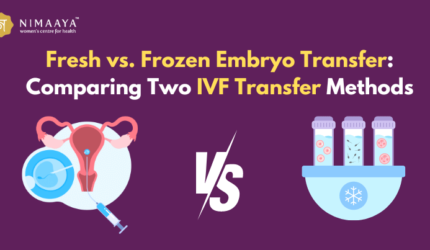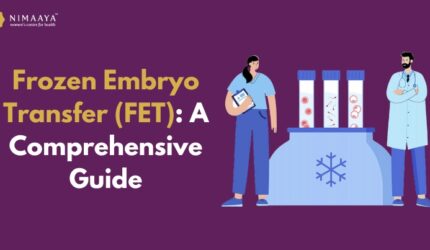Frozen embryo transfer or FET procedure is an integral part of IVF treatment. It involves transferring and thawing embryos created during a previous egg retrieval cycle to the uterus. Couples often opt for the frozen embryo transfer process because they cannot conceive after routine treatment, tubal factor, uterine causes, male factor, or any other factor. Moreover, one of the most common reasons for opting for FET is the availability of surplus embryos from a fresh cycle.
In this blog, we will delve into the benefits of the FET procedure, what the FET procedure is, the benefits of the FET procedure, and its pregnancy success rate.
Let’s get started!
Benefits of the FET Procedure
Compared to other fertility treatments, the FET procedure comparatively involves less risk and is less costly. If given an option to choose from, couples usually prefer this treatment. Let’s explore in depth the treatment’s various benefits:
-
Chances of Success Rate
The FET procedure has shown increasing success rates over the years, primarily attributed to carefully selecting high-quality embryos for transfer. Only those embryos that have demonstrated viability through the freezing and thawing process are chosen, increasing the successful pregnancy.
-
Enhanced Flexibility
The FET process allows for greater flexibility in terms of timing, as it separates the process of fertilization and embryo transfer stages. This will enable embryos to be frozen and used in future cycles, which can be better synchronized with a woman’s menstrual cycle.
-
Reduced Demand
Compared to fresh IVF cycles, FET requires fewer medications and hormonal injections because embryos are transferred during a natural or minimally uterine cycle.
The FET cycle relieves women from physical or emotional stress, making it a preferred choice for women who experience discomfort during ovarian stimulation.
-
Checking Genetic Screening
It is suggested to conduct preimplantation genetic testing (PGT) on the embryos before transfer. The particular testing helps detect any genetic abnormalities or chromosomal disorders and enables gender selection if desired. This selection process ensures the transfer of the healthiest embryo, reducing the risk of genetic conditions.
FET Procedure
To undergo the FET procedure, women may experience mild discomfort, but it is essential to understand the process thoroughly. In this section, we will provide a detailed explanation, step by step of the frozen embryo transfer process:
1) Preparation
Before beginning the FET procedure, the woman’s menstrual cycle is monitored closely to determine the optimal time for embryo transfer. At Nimaaya – IVF Center, our IVF fertility specialists carefully review your records, current and past medications, and your fertility history.
This includes essential tests such as ultrasounds and blood work to determine uterine suitability for transfer and monitor ovarian activity leading up to the frozen embryo transfer.
There are two types of cycle
- Hormonal support cycle (medications to prepare the uterine lining)
- Natural cycle
2) Uterine Lining Preparation
In a hormonal support cycle, specific hormone medications are employed to prepare the uterine lining for embryo implantation. This involves the use of two hormones:
-
Estrogen
Starting estrogen on the first day of your period is usually recommended. It is typically administered for 14 days in various forms, such as pills, injections, or patches. It stimulates the growth and thickening of the uterine lining to create a receptive environment for embryo implantation.
-
Progesterone
Progesterone is introduced after a period of estrogen administration and achieving the desired endometrium thickness. This hormone is usually administered in the form of vaginal suppositories, injection or gel. With the help of progesterone, it prepares the uterine lining further and supports the embryo growth and development.
3) Embryo Transfer
The frozen embryo transfer procedure is usually performed on the third or fifth day of the progesterone theory. In the case of natural cycle FET, embryos are thawed on the morning of the scheduled transfer. These embryos are then placed into a thin catheter, which is generally inserted through the cervix into the uterus.
The transfer of more embryos may increase the likelihood of multiple pregnancies, which increases the pregnancy risk for both women and the fetuses.
4) Post Transfer Care
After the embryo transfer, women may continue taking hormones such as estrogen and progesterone to maintain the uterine environment. There would also be a need to wait 10-14 days before undergoing a pregnancy test to determine whether the test was successful.
5) Hormonal Study – Pregnancy Test
A blood test is conducted to check the presence of pregnancy hormones in the woman’s bloodstream. There are two possibilities.
If the test is negative, the hormone therapy is discontinued, and a menstrual period usually begins within a few days.
If the test is positive, a procedure to measure serum progesterone levels is performed to assess and monitor the pregnancy.
Pregnancy Success Rate
A study observed that fertility was 28.62% of those who have undergone the FET, surpassing the success rates of fresh embryo transfer. This proves the success rate of getting higher chances of pregnancy by adopting the FET procedure.
It is observed that women aged 35 or younger tend to exhibit higher pregnancy rates per embryo transfer. In contrast, women over 40 may experience lower pregnancy rates per embryo transfer.
At Nimaaya, we always strive to increase our success rate year after year. With over a decade of experience, our fertility specialist has been successfully consulting and helping couples conceive through the FET procedure and other fertility treatments.
Factors that affect the success rate of the FET procedure are:
- Environmental factors
- Infectious factors
- Uterine factors
- Embryo genetic and quality
Summary
To summarize, we studied how the FET procedure can be the best option for individuals seeking fertility treatment. While there are various approaches to address infertility, we have delved into why FET stands out despite the numerous options available.
Nimaaya – IVF Center has been pioneering the IVF industry for over a decade and offers top-notch fertility facilities. Our commitment to excellence is in providing personalized care, leading to the best possible outcome for their fertility journey.
Consult an IVF specialist and get closer to your dream of building a complete family by consulting with our experienced specialist.




